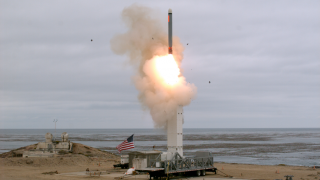Why the U.S. Army May Not Need to Jump on the Hypersonic Missile Bandwagon
Does America REALLY need hypersonic missiles? One military expert is not so sure.
Here's What You Need To Remember: One expert believes that, instead of hypersonic missiles, the Army should consider developing a stealthy ground-launched cruise missile that can be destroy ships, surface-to-air missile batteries, and command centers.
Does the U.S. Army really need to develop hypersonic missiles?
One expert has – gasp – dared to suggest that the Army shouldn’t jump on the hypersonic bandwagon.
“It is difficult to discern what operational problem the Army has that a hypersonic missile will help solve,” writes Thomas Spoehr in a Heritage Foundation study on Army modernization. “Yet the Army reportedly plans to spend $1.2 billion on a hypersonic missile over the next five years.”
Spoehr, a retired Army lieutenant general who heads the Center for National Defense at the Heritage Foundation, warns against the frenzy for superweapons.
“Washington, D.C., is awash today in predictions that combinations of artificial intelligence (AI), robotics (especially swarms), hypersonic weapons, railguns, and directed-energy weapons will fundamentally change warfare,” Spoehr writes. “Less plentiful are the operational concepts that describe how these systems will be used. Great significance is ascribed to the amounts of money that China and Russia are investing in advanced technologies such as hypersonic missiles and AI, while opinion pieces warn daily that the U.S. must ‘win’ the hypersonic missile race.”
But “the hypersonic missile ‘race’ need only be ‘won’ if, indeed, a hypersonic missile fills a necessary capability gap for the joint force,” he points out.
The U.S. is frantically moving to catch up with Russia and China in hypersonic weapons, which travel faster than Mach 5. Russia in particular has deployed an array of hypersonic missiles, including the Mach 10 air-launched Khinzal ballistic missile and the sea-launched Zircon anti-ship missile, and the Mach 27 Avangard, a nuclear-armed glider boosted high into the atmosphere atop an ICBM.
Note that none of these weapons have been used in combat, and there are questions about the stability and accuracy of missiles maneuvering at such speeds. Nonetheless, U.S. planners – stoked by Russian propaganda about unstoppable wonder weapons -- fear that hypersonic missiles are too fast to be intercepted by missile defenses.
Naturally, the U.S. (and Germany, and France, and Britain) wants its own hypersonics. The U.S. military is developing a common hypersonic glide body that can be used by the different services. The U.S. Army, intent on making long-range weapons the center of its future strategy, plans to deploy a battery of ground-launched hypersonic missiles by 2023.
Spoehr suggests an Army hypersonic missile might have unintended consequences. For example, long-range Army weapons could create interservice rivalries. “Many of the long-range fires the Army seeks, such as hypersonic missiles and ‘strategic cannons’ with their longer ranges, have in the past been provided by the Air Force, and the Air Force may feel threatened by these capabilities,” he writes.
Spoehr says he is not against hypersonic weapons per se. “The Army believes, probably with some justification, that the Air Force in a fight with a near peer competitor will have their hands full trying to establish air superiority against our adversary and will not have the ability to dedicate assets to eliminating key ground targets such as SAM [surface-to-air missile] batteries,” Spoehr tells the National Interest.
“But I have not heard an well-articulated concept of how the U.S. intends to use them or how they help us solve an operational problem,” he adds. “Typically the rational I hear why we should invest in them revolves around China and Russia’s investment in hypersonic weapons. Which is interesting, but not decisive.”
“I can understand why China wants them, perhaps to evade U.S. missile defenses and take out a key node such as an aircraft carrier or a C2 [command and control] node on Guam. “But Russia really does not have sophisticated theater ballistic missile defense systems. So what is the U.S. concept? Would we be better off investing our resources towards hypersonic missile defenses versus offense?”
Instead of hypersonic missiles, the Army should consider developing a stealthy ground-launched cruise missile that can be destroy ships, surface-to-air missile batteries, and command centers, Spoehr tells the National Interest. “Ground-launched cruise missiles can typically contain more of a destructive payload than a hypersonic missile which are constrained by the need to design a heat resistant and aerodynamic warhead. Ground-launched cruise missiles can also contain a more sophisticated seeker head, again because there is no need to design it to withstand speeds of 6,174 kilometers per hour.”
More important, instead of building hypersonic missiles, the Army should be developing defenses against hypersonic weapons. Indeed, the Pentagon is already pursuing defensive solutions, such as interceptor rockets and even lasers.
Given the relentless “if they have them, so must we” dynamics of arms races, it is that hypersonic weapons will be developed by multiple nations. But there is nothing magical about hypersonic missiles. They are missiles that merely travel faster than older missiles. And like any weapon, hypersonic missiles must have a purpose and mission other than merely acquiring them for the sake of acquiring them.
Michael Peck is a contributing writer for the National Interest. He can be found on Twitter and Facebook. This article was originally published a few years ago.
Image: Reuters.

